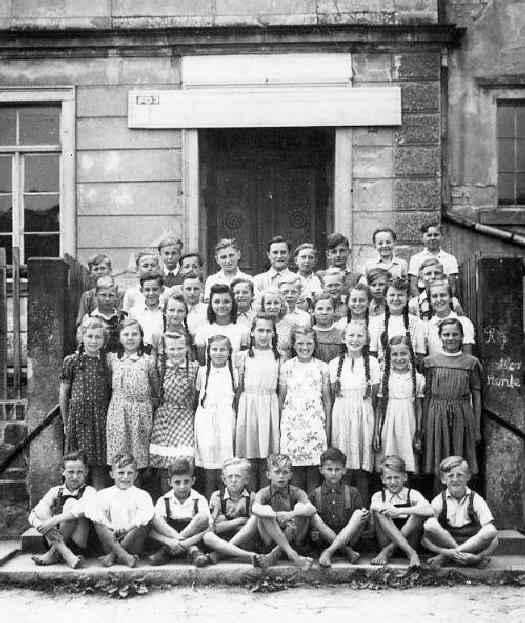
German Young Pioneer Levels: Freie Deutsche Jugend (FDJ)

Figure 1.-- There is a FDJ sign above the entrance here. I had thought that the FDJ activities were primarily school based, but this seems to be a non-school facility. It may havec been located in Berlin.
The image shows part of the reason that the Soviets lost the Cold war. Communism was susposed to create a worker's paradise and prosperity. Yet in this 1951 scene when the West German economy was beginnikng an Economic Mircle, these children did not even have shoes.
|
|
The Freie Deutsche Jugend (FDJ--Free German Youth) was the official youth movement of the DDR.
Young people between the ages of 14-25 joined the FDJ). The organization was founded, however, before World War II and the creation of the DDR. Hitler's first major step in becoming Chancelor ws to move against the Communist Party (1933). All Communist Party institutions were supressed, including youth movements. The FDJ was subsequntly founded to opose the NAZIS (1936). The Gestapo effectively prevented such groups from operating within the Reich. The FDJ operated from Paris (1936) and then Prague (1938). After the Munich Accords and the Germsn conquest of most of Europe, the FDJ moved to flee to Englnd. After the War, the FDJ moved back to Germnany, setting up in the Soviet occupstion zone and entered German politics under Soviet protection. With the onset of the Cold War and the organization of the DDR, the FDJ took on a role similsr to the Komosol in the Soviet Union. The communist World Federation of Democratic Youth recognized it at its annual meeting in Otwock, Poland (1948). The FDJ operated for a while in West Germany as well as East Germany. The West German Government, however, banned the German Communist Party (KPD) along with affiliated grouos like the FDJ (1951).
The FDJ in East Germany was was a member of the National Front and was represented in the DDR People's Chamber. The FDJ was responsible for the ideological prepsaration of young Germsans in Marxism-Leninism. As part of thsat effort, it organized a range of activities appealing to teenagers and young adults, including holidays through its Jugendtourist agency. Thre FDJ ran discos. German children after the Thälmann Pioneers, would usually join the FDJ. Membership was not mandatory, but in East Germsny failure to join would hsve a substantial negative impsct on yhe undividual's life. Those who refused to join not only were unable to enjoy the organized holidays, but also other soicial activities. More importantly, it also meant that the young people could not pursue a university education, regardless of their academic qualificatins. Most of the youth who refused to join, did so out of religuious convictions.
HBU

Navigate the Historic Boys' Uniform Chronology Pages:
[Return to the Main chronologies page]
[The 1900s]
[The 1910s]
[The 1920s]
[The 1930s]
[The 1940s]
[The 1950s]
[The 1960s]
[The 1970s]
[The 1980s]
[The 1990s]
[The 2000s]
Navigate the Historic Boys' Uniform Web Site:
[Return to the Main German Young Pioneer page]
[Activities]
[Biographies]
[Chronologies]
[Countries]
[Essays]
[Garments]
[Organizations]
[Religion]
[Other]
[Introduction]
[Bibliographies]
[Contributions]
[FAQs]
[Questions]
[Unknown images]
[Boys' Uniform Home]
Navigate the Historic Boys' Uniform Web organizatiion pages:
[Boys' Brigade]
[Camp Fire]
[Hitler Youth]
[National]
[Pioneers]
[Royal Rangers]
[Scout]
Created: 6:39 AM 7/20/2008
Last updated: 6:39 AM 7/20/2008



